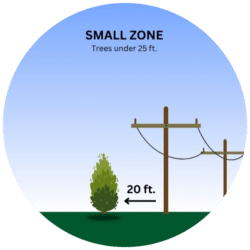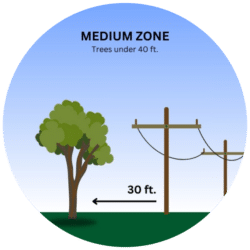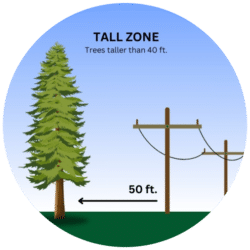Planting Trees Near Power Lines
The Right Tree In The Right Place
- Electric Safety >
- Planting Trees Near Power Lines
UGI is committed to providing safe and reliable electricity to its customers, but we can’t do it alone. Trees are the leading cause of customer outages and with your help we can reduce the number of these outages simply by planting the right tree in the right place.
Before Planting Near Power Lines, Consider These Tips:
UGI’s distribution lines deliver the power from our substations to customers. Typically, these lines are located along the roads, and you often see our line clearance contractors trimming or removing trees. The purpose of this work is to keep tree limbs away from our distribution lines, decreasing the instances of momentary power interruptions, or remove trees that are considered unhealthy or pose a serious risk to our facilities.
Call Before You Dig…It’s the Law
It is very important to call 811 before breaking ground to identify the location of underground utilities. Current laws require underground utilities to be located and marked at least three (3) days before the start of any project. This service is free, essential for your safety, and avoids the possibility of damaging underground utilities.
Consider the Planting Location
One of the most important decisions before planting a new shrub or tree is location. Power lines can be located along the road, through backyards or wooded section of your property. The following suggestions will help reduce power interruptions.
If planting directly beneath the distribution lines, smaller trees or shrubs under 25 feet are appropriate. Trees that are taller at maturity, need to be planted further from the distribution lines.
Trees reaching 40 feet in height at maturity or less should be planted at least 30 feet from the distribution lines to account for the width of the canopy.
Trees greater the 40 feet at maturity should be planted at least 50 feet from the distribution line.

SMALL ZONE
Zone: 20ft. from Distribution Lines
Trees: < 25ft. at Maturity

MEDIUM ZONE
Zone: 30ft. from Distribution Lines
Trees: < 40ft. at Maturity

TALL ZONE
Zone: 50ft. from Distribution Lines
Trees: > 50ft. at Maturity
Choose the Right Shrub or Tree
Plant selection is critical to ensure that the tree you plant does not impact utility facilities in the future. Below are common shrubs and trees that are recommended species to plant near UGI’s facilities.
Small Shrubs
- American Yew-Ground Hemlock (Taxus canadensis)
- Blackberry (Rubus allegheniensis)
- Blueberries (Vaccinium spp.)
- Hazelnut (Corylus spp.)
- Huckleberries (Gaylussacia spp.)
- Meadowsweet (Spirea spp.)
- Mountain Laurel (Kalmia latifolia)
- Raspberry (Rubus occidentalis)
- Scrub Oak (Quercus spp.)
- Sweetfern (Comptonia peregrina)
- Trailing Arbutus (Epigaea repens)
- Tree Lilac (Syringa reticulata)
- Viburnums (Viburnum spp.)
- Wintergreen (Gaultheria procumbens)
Large Shrubs
- Alder (Alnus spp.)
- Chokeberry (Pyrus arbutifolia)
- Common Chokecherry (Prunus virginiana)
- Dogwood (Cornus spp.)
- Elderberry (Sambucus spp.)
- Rhododendron (Rhododendron maximum)
- Smooth (Dwarf) Sumac (Rhus typhina)
- Spicebush (Lindera benzoin)
- Staghorn Sumac (Rhus typhina)
- Virburnum (Virburnum spp.)
- Witch-hazel (Hamamelis virginiana)
Small Trees
- Blue Beech (American Hornbearn) (Carpinus caroliniana)
- Deciduous Holly (Winterberry) (Ilex verticillate)
- Dwarf Willow (Salix spp.)
- Eastern Red Cedar (Juniperus virginia)
- Flowering Dogwood (Cornus florida)
- Hawthorn (Crataegus spp.)
- Northern White Cedar (Thuja occidentalis)
- Redbud (Cercis canadensis)
- Shadbush (Juneberry, Serviceberry) (Amelanchier spp.)